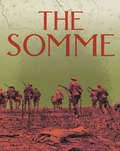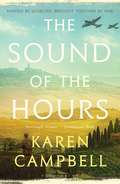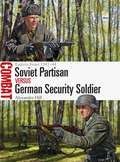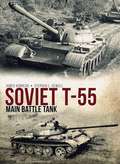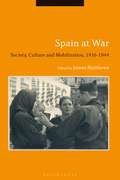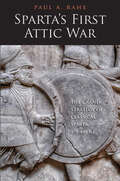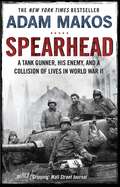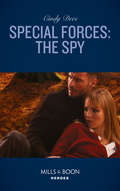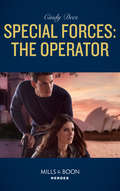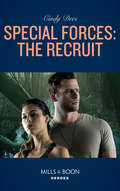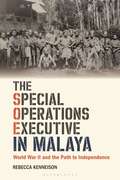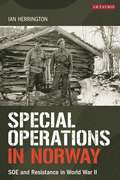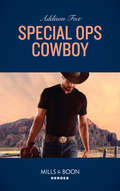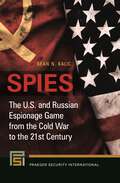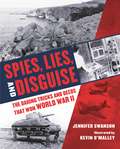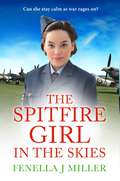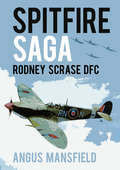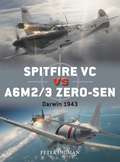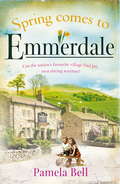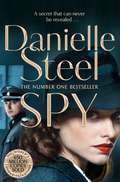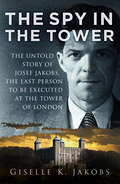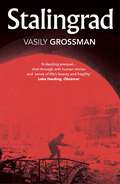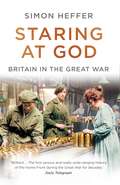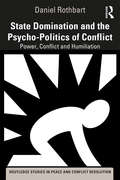- Table View
- List View
The Somme
by Sarah RidleyFor many people the word 'Somme' sums up the carnage and futility of the First World War. The failure of Allied forces to achieve their objectives at such a huge cost in human lives has resonated in military circles for the past 100 years. This book tells the story of the battle and its wider repercussions, and analyses its importance to the overall outcome of the First World War. The Somme investigates the build-up to the battle, why leaders thought the action was necessary and what they thought it would achieve. It looks at the forces involved, including the 'Pals' battalions - patriotic friends who fought, and more often than not died, together. Although not a straightforward timeline, the book outlines the actual course of the battle beginning on 1 July 1916 and the impact of the continuing slaughter on both sides. Quotes from those who took part offer a glimpse of what it must have been like to be there, and maps show how little was actually achieved in terms of a breakthrough. Poetry, art and music inspired by the Somme campaign bring the soldiers' harrowing experiences to life. Suitable for readers aged 11 and up.
The Sound of the Hours
by Karen CampbellDivided by loyalties, brought together by warSeptember, 1943. Tuscany, Italy. In the hilltop town of Barga, everyone holds their breath. Even the bells fall silent. Everything Vittoria Guidi knows and loves is at risk. German troops occupy the mountains around her home, as America's Buffalo Soldiers prepare to invade. As Vittoria's country is torn in two, so is her conscience. Should she side with her Scots-Italian father or her Fascist mother? Should she do what she is told – or what she believes in?Frank Chapel, a young, black American soldier fighting with the Buffalo soldiers for a country that refuses him the vote, is unlike anyone Vittoria has ever met. In the chaos, they find each other – but can their growing love overcome prejudice and war?
Soviet Partisan vs German Security Soldier: Eastern Front 1941–44 (Combat)
by Alexander HillThe savage partisan war on the Eastern Front during World War II saw a wide variety of forces deployed by both sides. On the Soviet side, civilian partisans fought alongside and in co-operation with Red Army troops and Red Army and NKVD 'special forces'. On the German side, German Army security divisions, with indigenous components including cavalry, fought alongside SS police and Waffen-SS units and other front-line troops employed for short periods in the anti-partisan role. In addition to providing the background history of the forces of both sides, this study focuses upon three examples of German anti-partisan operations that show varied success in dealing with the Soviet partisan threat. Notably, it covers a major operation in north-west Russia during the spring of 1943 – Operation Spring Clean – that saw Wehrmacht security forces including local components fighting alongside troops under the SS umbrella against a number of Soviet partisan brigades. During the fighting, German forces even employed captured French tanks from earlier in the war against the partisans. Featuring specially commissioned artwork and drawing upon an array of sources, this is an absorbing account of the brutal fighting between German security forces and their Soviet partisan opponents during the long struggle for victory on World War II's Eastern Front.
Soviet T-55 Main Battle Tank
by James Kinnear Stephen SewellThe T-55 is one of the most iconic weapons created by the Soviets during the Cold War and also one of the most widely deployed weapons in history. Like its younger brother, the T-54, the T-55 enjoyed a long career in the Red Army and even into the early days of the reformed Russian Army. Under their control it saw very little combat use or deployments, but it was widely sold to other nations and participated in many of the wars and combat operations from the mid-1960s to the present. The T-55 has been employed in almost every conflict in the Middle East and Africa from its introduction into service. Even today the tank is still employed by both sides in the Syrian Civil War, and they are also in service with Kurdish forces in the struggle against ISIS in the northern part of Iraq. Containing more than 400 stunning contemporary and modern photographs, and written by two experts on Soviet armour, this authoritative book tells the complete story of the T-55, one of the most widely produced tanks of all time.
Spain at War: Society, Culture and Mobilization, 1936-44
by James MatthewsSpain's principal and most devastating war during the 20th century was, unusually for most of Europe, an internal conflict. During the Spanish Civil War of 1936 to 1939 two competing armies – the insurgent and counterrevolutionary Nationalist Army and the Republican Popular Army – engaged in a conflict to impose their version of Spanish identity and the right to shape the country's future. In its aftermath, Francoist Spain remained on a war footing for the duration of the Second World War. In spite of the unabated flood of books on the Spanish Civil War and its consequences, historians of Spain in the 20th century have focused relatively little on the interaction of society and culture, and their roles in wartime mobilization. Spain at War addresses this omission through an examination of individual experiences of conflict and the mobilization of society. This edited volume acknowledges the agency of low-ranking individuals and the impact of their choices upon the historical processes that shaped the conflict and its aftermath. In doing so, this new military history provides a more complex and nuanced understanding of Spain's most intense period of wartime cultural mobilization between the years 1936 to 1944 and challenges traditional political accounts of the period.
Sparta's First Attic War: The Grand Strategy of Classical Sparta, 478-446 B.C. (Yale Library of Military History)
by Paul Anthony RaheA companion volume to The Spartan Regime and The Grand Strategy of Classical Sparta that explores the collapse of the Spartan†‘Athenian alliance During the Persian Wars, Sparta and Athens worked in tandem to defeat what was, in terms of relative resources and power, the greatest empire in human history. For the decade and a half that followed, they continued their collaboration until a rift opened and an intense, strategic rivalry began. In a continuation of his series on ancient Sparta, noted historian Paul Rahe examines the grounds for their alliance, the reasons for its eventual collapse, and the first stage in an enduring conflict that would wreak havoc on Greece for six decades. Throughout, Rahe argues that the alliance between Sparta and Athens and their eventual rivalry were extensions of their domestic policy and that the grand strategy each articulated in the wake of the Persian Wars and the conflict that arose in due course grew out of the opposed material interests and moral imperatives inherent in their different regimes.
Spearhead: An American Tank Gunner, His Enemy and a Collision of Lives in World War II
by Adam MakosThe New York Times Bestseller'Brilliant... Gripping' Wall Street JournalFrom the Sunday Times bestselling author of A Higher Call comes the riveting World War II story of an American tank gunner's journey into the heart of the Third Reich. At first, gunner Clarence Smoyer and his fellow crewmen in the legendary 3rd Armored Division - 'Spearhead' - thought their tanks were invincible. Then they met the German Panther, with a gun so murderous it could shoot through one Sherman and into the next. Soon a pattern emerged: the lead tank always gets hit.After Clarence sees his friends cut down breaching the West Wall and holding the line in the Battle of the Bulge, he and his crew are given a weapon with the power to avenge their fallen brothers: the Pershing, a state-of-the-art 'super tank', one of twenty in the European theatre.But with it comes a harrowing new responsibility: now they will spearhead every attack. That's how Clarence finds himself leading the U.S. Army into its largest urban battle of the European war, the fight for Cologne, the 'Fortress City' of Germany.Battling through the ruins, Clarence will engage the fearsome Panther in a duel immortalized by an army cameraman. And he will square off with Gustav Schaefer, a teenager behind the trigger in a Panzer IV tank, whose crew has been sent on a suicide mission to stop the Americans.As Clarence and Gustav trade fire down a long boulevard, they are confronted by a tragic mistake of war. What happens next will haunt Clarence to the modern day, drawing him back to Cologne to do the unthinkable: to face his enemy, one last time.
Special Forces: Identical Stranger / Special Forces: The Spy (mission Medusa) (Mission Medusa #2)
by Cindy DeesA secret agent kidnaps an undercover operative!
Special Forces: The Operator (Mission Medusa #3)
by Cindy DeesBound together by duty… Staying together by passion
Special Forces: The Recruit (Mission Medusa #1)
by Cindy DeesTheir mission? Save the world—and each other! A Military Precision Heroes romance
The Special Operations Executive in Malaya: World War II and the Path to Independence
by Rebecca KenneisonDuring World War II, agents of the Special Operations Executive (SOE) infiltrated Japanese-occupied Malaya. There they worked with Malayan guerrilla groups, including the communist-sponsored Malayan Peoples Anti-Japanese Army (MPAJA), regarded as the precursor of the communist insurgent army of the Malayan Emergency. This book traces the development of SOE's Malayan operations, and analyses the interactions between SOE and the various guerrilla groups. It explores the reasons for and the extent of Malay disillusionment with Japanese rule, and demonstrates how guerrilla service acted as a training ground for some later Malay leaders of the independent nation. However, the reports written about the MPAJA by SOE operatives just after the war failed to draw out the likely future threat posed by the communists to the returning colonial administration. Rebecca Kenneison shows that the British possessed a wealth of local information, but failed to convert it into active intelligence in the period prior to the Malayan Emergency. In doing so she provides new insights into the impact of SOE on Malayan politics, the nature of Malayan communism's challenge to colonial rule, and British post-war intelligence in Malaya.
Special Operations in Norway: SOE and Resistance in World War II (International Library of War Studies)
by Ian HerringtonBetween 1940 and 1945, Britain's Special Operations Executive (SOE) carried out sabotage and organised resistance across occupied Europe. Over 5 years, SOE sent over 500 agents into Norway to carry out a range of operations from sabotage and assassination to attempts to organise an underground guerrilla army. This book is the first multi-archival, international academic analysis of SOE's policy and operations in Norway and the influences that shaped them, challenging previous interpretations of the relationship between this organisation and both the Norwegian authorities and the Milorg resistance movement.
Spies: The U.S. and Russian Espionage Game from the Cold War to the 21st Century (Praeger Security International)
by Sean N. KalicIn the post-World War II era, the Soviet Union and the United States wanted to gain the advantage in international security. Both engaged in intelligence gathering. This book provides a comprehensive understanding of the evolution of the espionage game.For more than four decades after World War II, the quest for intelligence drove the Soviet Union and the United States to develop a high-stakes "game" of spying on one another throughout the Cold War. Each nation needed to be aware of and prepared to counter the capabilities of their primary nemesis. Therefore, as the Cold War period developed and technology advanced, the mutual goal to maintain up-to-date intelligence mandated that the process by which the "game" was played encompass an ever-wider range of intelligence gathering means. Covering far more than the United States and Soviet Union's use of human spies, this book examines the advanced technological means by which the two nations' intelligence agencies worked to ensure that they had an accurate understanding of the enemy.The easily accessible narrative covers the Cold War period from 1945 to 1989 as well as the post-Cold War era, enabling readers to gain an understanding of how the spies and elaborate espionage operations fit within the greater context of the national security concerns of the United States and the Soviet Union. Well-known Cold War historian Sean N. Kalic explains the ideological tenets that fueled the distrust and "the need to know" between the two adversarial countries, supplies a complete history of the technological means used to collect intelligence throughout the Cold War and into the more recent post-Cold War years, and documents how a mutual desire to have the upper hand resulted in both sides employing diverse and creative espionage methods.
Spies: The U.S. and Russian Espionage Game from the Cold War to the 21st Century (Praeger Security International)
by Sean N. KalicIn the post-World War II era, the Soviet Union and the United States wanted to gain the advantage in international security. Both engaged in intelligence gathering. This book provides a comprehensive understanding of the evolution of the espionage game.For more than four decades after World War II, the quest for intelligence drove the Soviet Union and the United States to develop a high-stakes "game" of spying on one another throughout the Cold War. Each nation needed to be aware of and prepared to counter the capabilities of their primary nemesis. Therefore, as the Cold War period developed and technology advanced, the mutual goal to maintain up-to-date intelligence mandated that the process by which the "game" was played encompass an ever-wider range of intelligence gathering means. Covering far more than the United States and Soviet Union's use of human spies, this book examines the advanced technological means by which the two nations' intelligence agencies worked to ensure that they had an accurate understanding of the enemy.The easily accessible narrative covers the Cold War period from 1945 to 1989 as well as the post-Cold War era, enabling readers to gain an understanding of how the spies and elaborate espionage operations fit within the greater context of the national security concerns of the United States and the Soviet Union. Well-known Cold War historian Sean N. Kalic explains the ideological tenets that fueled the distrust and "the need to know" between the two adversarial countries, supplies a complete history of the technological means used to collect intelligence throughout the Cold War and into the more recent post-Cold War years, and documents how a mutual desire to have the upper hand resulted in both sides employing diverse and creative espionage methods.
Spies, Lies, and Disguise: The Daring Tricks and Deeds That Won World War II
by Jennifer SwansonIn the late 1930s, times were desperate. The world found itself at war again, less than twenty years after the first World War had ended. No one could quite believe it. And no one wanted it. The leaders of every country involved were left with no choice. They had to try to end the war as fast as possible, using whatever means they could. That meant coming up with secret operations meant to deceive, deflect, and confuse their enemies. Poison the cattle that the Germans eat? Deliberately float a corpse dressed up as a spy across the water to have it wash up on Germany's shore? Create a unit of top secret commandos with a license to kill? These were all real tactics attempted with the ultimate goal of defeating Hitler. In this off-center look at history, readers will be captivated by the classified and covert efforts made by each side as they tried to gain the upper hand and win the war. Restricted access is lifted to give the reader a peek into the top secret operations of the daring men and women who fought the war under a cloak of secrecy.
The Spitfire Girl in the Skies: A heartwarming and romantic WW2 saga (The Spitfire Girl #2)
by Fenella J. MillerThe second Spitfire Girl novel from bestselling author Fenella J Miller. The ATA training base, Hampshire, 1940. Ellie Simpson is attached to an Air Transport Auxiliary base in Hampshire. Life as an ATA pilot is tough, but despite the long hours and danger, Ellie can think of nowhere she'd rather be. Not only does she love flying, but doing important war work, alongside new-found friends, provides a welcome distraction from worrying about loved ones fighting on the front line. Being an ATA girl is definitely exciting, but as Ellie soon finds out wearing the distinctive blue uniform also means putting her life on the line every time she takes to the skies. It will take friendship and a strength she didn't know she possessed to help her county – and those she loves – to survive. An inspiring story of an incredible girl going above and beyond during World War II.
Spitfire Saga: Rodney Scrase DFC
by Angus MansfieldRODNEY SCRASE’s life in the RAF began in an old airship shed when he took the King’s shilling in May 1941. He learnt to fly at a British Flying Training School in America and went on to fly Spitfires with Nos 72 and 1 Squadrons, and was awarded the Distinguished Flying Cross in 1944. He was released from service with a record of four enemy aircraft destroyed and three damaged, having taken part in the invasions of North Africa, Sicily and Italy, following up with a stint as an instructor in the art of air-to-air gunnery in Egypt. He finished the war flying escort missions with No. 1 Squadron from Manston, Kent. In Spitfire Saga Angus Mansfield presents the unique story of one man’s experience of flying the most iconic aircraft of the Second World War, using Rodney’s own logbooks and first-hand interviews with him and several other pilots. Complete with thorough historical context and a selection of Rodney’s personal photographs, this book is an excellent addition to any history enthusiast’s library. A true insider’s view of life as an RAF fighter pilot.
Spitfire VC vs A6M2/3 Zero-sen: Darwin 1943 (Duel)
by Peter IngmanJust weeks after Pearl Harbor, Darwin was mauled by a massive Japanese attack. Without a single fighter to defend Australian soil, the Australian government made a special appeal to Britain for Spitfires. A year later the Spitfire VC-equipped No 1 Fighter Wing, RAAF, faced the battle-hardened 202nd Kokutai of the IJNAF, equipped with A6M2 Zero-sens, over Darwin. This was a gruelling campaign between evenly matched foes, fought in isolation from the main South Pacific battlegrounds. Pilots on either side had significant combat experience, including a number of Battle of Britain veterans. The Spitfire had superior flight characteristics but was hampered by short range and material defects in the tropical conditions, while the Japanese employed better tactics and combat doctrine inflicting serious losses on the over-confident Commonwealth forces. Fully illustrated with detailed full-colour artwork, this is the gripping story of two iconic aircraft facing off against each other above Australia.
Spring Comes to Emmerdale: The perfect gift for Easter (Emmerdale Ser.)
by Pamela BellTHE PERFECT TREAT FOR EASTERSpring Comes to Emmerdale is a must for fans of ITV's Emmerdale, and readers who love heartwarming and heartbreaking stories set during wartime, alike.'Enthralling. Spring Comes to Emmerdale is beautifully written and researched' - Lancashire Evening PostWorld War I wages on, and the families of Emmerdale are trying their best to move on from tragedy, while the effects of war still resonate throughout the village of Beckindale. Though grief and loss permeate, Maggie Sugden, Rose Haywood and the other inhabitants of the village are finding independence, the chance to make their own happiness - and even opening themselves up to find love. Featuring firm fan favourites like the Dingles, The Woolpack Pub and Emmerdale Farm itself, this will be a delight for any Emmerdale fan.Following on from the first in the series, Christmas At Emmerdale, the second novel picks up where the first left-off, exploring the lives of Emmerdale's much-loved families during the Great War and beyond, and how the nation's favourite village copes with the loves and lives lost.
Spy: A Novel
by Danielle SteelA young woman is caught up in a dangerous double life on behalf of her country during World War Two in Spy, by the world's favourite storyteller Danielle Steel.At eighteen, Alexandra Wickham is presented to King George V and Queen Mary. She is a stunning beauty who seems destined for a privileged life. But fate, a world war and her own quietly rebellious nature lead her down a different path.By 1939, Britain is at war. From her home in idyllic Hampshire Alex makes her way to London as a nursing volunteer. But her fluency in French and German draws the attention of another, more secret, branch of the service.Within a year, Alex is immersed in a new world, shocking her family in trousers and bright red lipstick. But she is forbidden to tell anyone about her work, not even the pilot she falls in love with. While her country and those dearest to her pay the terrible price of war, Alex learns the art of espionage, leading to life-and-death missions and a long career in exotic places and historic times.Spy follows Alex’s extraordinary adventures during the war, and afterwards all over the world, when her husband, Richard, enters the foreign service. She lives life on the edge, with a secret she must always keep hidden.
The Spy in the Tower: The Untold Story of Joseph Jakobs, the Last Person to be Executed in the Tower of London
by Giselle K. JakobsA family man who ran afoul of the Nazis, Josef Jakobs was ill-prepared for an espionage mission to England. Captured by the Home Guard after breaking his ankle, Josef was interrogated at Camp 020, before being prosecuted under the Treachery Act 1940 and executed on 15 August 1941. An open and shut case? MI5’s files suggest otherwise. Faced with the threat of a German invasion in 1940/41, MI5 used promises and threats to break enemy agents, extract intelligence and turn some into double agents, challenging the validity of the ‘voluntary’ confessions used to prosecute captured spies. But, more than that – was Josef set up to fail? Was he a sacrifice to test the double-cross system? The Spy in the Tower tells the untold story of one of Nazi Germany’s failed agents, and calls into question the legitimacy of Britain’s wartime espionage trials and the success of its double-cross system.
Stalingrad
by Vasily Grossman'One of the great novels of the 20th century' ObserverIn April 1942, Hitler and Mussolini plan the huge offensive on the Eastern Front that will culminate in the greatest battle in human history.Hundreds of miles away, Pyotr Vavilov receives his call-up papers and spends a final night with his wife and children in the hut that is his home. As war approaches, the Shaposhnikov family gathers for a meal: despite her age, Alexandra will soon become a refugee; Tolya will enlist in the reserves; Vera, a nurse, will fall in love with a wounded pilot; and Viktor Shtrum will receive a letter from his doomed mother which will haunt him forever.The war will consume the lives of a huge cast of characters - lives which express Grossman's grand themes of the nation and the individual, nature's beauty and war's cruelty, love and separation.For months, Soviet forces are driven back inexorably by the German advance eastward and eventually Stalingrad is all that remains between the invaders and victory. The city stands on a cliff top by the Volga River. The battle for Stalingrad - a maelstrom of violence and firepower - will reduce it to ruins. But it will also be the cradle of a new sense of hope.Stalingrad is a magnificent novel not only of war but of all human life: its subjects are mothers and daughters, husbands and brothers, generals, nurses, political officers, steelworkers, tractor girls. It is tender, epic, and a testament to the power of the human spirit.'You will not only discover that you love his characters and want to stay with them - that you need them in your life as much as you need your own family and loved ones - but that at the end... you will want to read it again' Daily Telegraph THE PREQUEL TO LIFE AND FATE NOW AVAILABLE IN ENGLISH FOR THE FIRST TIME, STALINGRAD IS A SUNDAY TIMES BESTSELLER AND NOW A MAJOR RADIO 4 DRAMAWINNER OF MODERN LANGUAGE ASSOCIATION "LOIS ROTH AWARD" FOR TRANSLATIONS FROM ANY LANGUAGE
Staring at God: Britain in the Great War
by Simon HefferThe Great War evokes images of barbed wire and mud-filled trenches, and of the carnage of the Somme and Passchendaele, but it also involved change on the home front on an almost revolutionary scale. In his hugely ambitious and deeply researched new book, Simon Heffer explores how Britain was drawn into this slaughter, and was then transformed to fight a war in which, at times, its very future seemed in question. After a vivid account of the fraught conversations between Whitehall and Britain’s embassies across Europe as disaster loomed in July 1914, Heffer explains why a government so desperate to avoid conflict found itself championing it. He describes the high politics and low skulduggery that saw the principled but passive Asquith replaced as prime minister by the unscrupulous but energetic Lloyd George; and he unpicks the arguments between politicians and generals about how to prosecute the war, which raged until the final offensive. He looks at the impact of four years of struggle on everyday life as people sought to cope with dwindling stocks of food and essential supplies, with conscription into the Army or wartime industries, with air-raids and with the ever-present threat of bereavement; and, in Ireland, with the political upheaval that followed the Easter Rising. And he shows how, in the spring of 1918, political obstinacy and incompetence saw all this sacrifice almost thrown away. Throughout, he complements his analysis with vivid portraits of the men and women who shaped British life during the war – soldiers such as Lord Kitchener, politicians such as Churchill, pacifists such as Lady Ottoline Morrell, and overmighty subjects such as the press magnate Lord Northcliffe. The result is a richly nuanced picture of an era that endured suffering and loss on an appalling scale but that also advanced the emancipation of women, notions of better health care and education, and pointed the way to a less deferential, more egalitarian future.
State Domination and the Psycho-Politics of Conflict: Power, Conflict and Humiliation (Routledge Studies in Peace and Conflict Resolution)
by Daniel RothbartThis book offers a detailed study of the psycho-politics of governmental manipulation, in which a vulnerable population is disciplined by contorting their sense of self-worth. In many conflict settings, a nation’s government exerts its dominance over a marginalized population group through laws, policies and practices that foster stark inequality. This book shows how such domination comes in the form of systems of humiliation orchestrated by governmental forces. This thesis draws upon recent findings in social psychology, conflict analysis, and political sociology, with case studies of governmental directives, verdicts, policies, decisions and norms that, when enforced, foster debasement, disgrace or denigration. One case centers on the US immigration laws that target vulnerable population groups, while another focuses on the ethnic discrimination of the central government of Sudan against the Sudanese Africans. The book’s conclusion focuses on compassion-motivated practices that represent a counter-force to government-sponsored strategies of systemic humiliation. These are practices for building peace by professionals and non-professionals as a positive response to protracted violence. This book will be of much interest to students of peace and conflict studies, sociology, psychology, ethics, philosophy and international relations.
